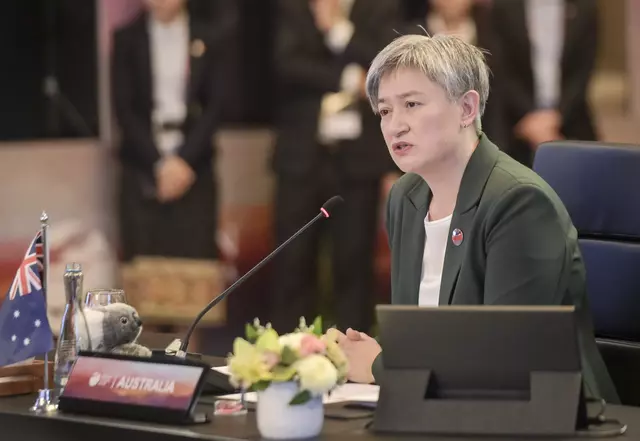Australia to Give ASEAN A$775M Development Aid This Year
Australia to Give ASEAN A$775M Development Aid This Year Jakartaglobe.id


Australia to Provide A$775 Million in Development Assistance to Southeast Asia

Jakarta. Australia on Thursday unveiled its plans to provide A$775 million (US$530 million) in development assistance to Southeast Asia, including Timor-Leste, as it seeks to bolster ties with ASEAN.
Australian Foreign Affairs Minister Penny Wong made the announcement during a ministerial-level meeting with her ASEAN counterparts.
“The [Australian] government has invested an additional $470 million in development assistance for Southeast Asia over the four years. We will contribute $775 million to Southeast Asia and Timor Leste this year,” Wong told the forum.
Australia is aiming to increase its official development assistance to A$1.24 billion in 2023-24 as part of its strategy to deepen its engagement with Southeast Asia. The Australian government data shows that it has set aside an estimated A$326.1 million in official development assistance to Indonesia for the 2023-24 period.
Australian Development Aid to Indonesia
- Indonesia received about A$323.8 million worth of Australian development aid in 2021-22.
- This was higher than what the Australian government’s initial budget estimates of A$299 million.
- The 2021-22 development assistance mostly went to the following sectors:
- Governance sector (32 percent)
- Economic infrastructure and services (16 percent)
Stronger Economic Cooperation
According to Penny, stronger ties with Southeast Asia have become a priority for its government, particularly from an economic and security standpoint. Australia-ASEAN two-way trade amounted to $127 billion in 2021. Penny said there remained huge room for growth in the ASEAN-Australia trade.
“We believe there is much more opportunity to be captured and to grow between us. To that end, we will soon release the Southeast Asia Economic Strategy to 2040, which will set out a practical pathway to strengthen Australia’s economic engagement with Southeast Asia,” Wong said.
The Australian Trade Ministry’s official website reported that its two-way trade with ASEAN in 2021 was greater than what Australia traded with Japan and the US. Australia, along with the 10 ASEAN member states, are also the signatories to the world’s largest trade deal Regional Comprehensive Economic Partnership (RCEP) agreement.
Read More: Australia Announces $50m Climate Funding for Indonesian SMEs
SDGs, Targets, and Indicators in the Article
1. Which SDGs are addressed or connected to the issues highlighted in the article?
- SDG 8: Decent Work and Economic Growth
- SDG 17: Partnerships for the Goals
2. What specific targets under those SDGs can be identified based on the article’s content?
- Target 8.1: Sustain per capita economic growth in accordance with national circumstances and, in particular, at least 7 percent gross domestic product growth per annum in the least developed countries.
- Target 17.2: Enhance global macroeconomic stability, including through policy coordination and policy coherence.
- Target 17.9: Enhance international support for implementing effective and targeted capacity-building in developing countries to support national plans to implement all the Sustainable Development Goals, including through North-South, South-South, and triangular cooperation.
3. Are there any indicators mentioned or implied in the article that can be used to measure progress towards the identified targets?
- Indicator 8.1.1: Annual growth rate of real GDP per capita.
- Indicator 17.2.1: Net official development assistance, total and to least developed countries, as a proportion of the Organization for Economic Cooperation and Development (OECD) Development Assistance Committee donors’ gross national income.
- Indicator 17.9.1: Dollar value of financial and technical assistance (including through North-South, South-South, and triangular cooperation) committed to developing countries.
Table: SDGs, Targets, and Indicators
| SDGs | Targets | Indicators |
|---|---|---|
| SDG 8: Decent Work and Economic Growth | Target 8.1: Sustain per capita economic growth in accordance with national circumstances and, in particular, at least 7 percent gross domestic product growth per annum in the least developed countries. | Indicator 8.1.1: Annual growth rate of real GDP per capita. |
| SDG 17: Partnerships for the Goals | Target 17.2: Enhance global macroeconomic stability, including through policy coordination and policy coherence. | Indicator 17.2.1: Net official development assistance, total and to least developed countries, as a proportion of the Organization for Economic Cooperation and Development (OECD) Development Assistance Committee donors’ gross national income. |
| Target 17.9: Enhance international support for implementing effective and targeted capacity-building in developing countries to support national plans to implement all the Sustainable Development Goals, including through North-South, South-South, and triangular cooperation. | Indicator 17.9.1: Dollar value of financial and technical assistance (including through North-South, South-South, and triangular cooperation) committed to developing countries. |
Behold! This splendid article springs forth from the wellspring of knowledge, shaped by a wondrous proprietary AI technology that delved into a vast ocean of data, illuminating the path towards the Sustainable Development Goals. Remember that all rights are reserved by SDG Investors LLC, empowering us to champion progress together.
Source: jakartaglobe.id

Join us, as fellow seekers of change, on a transformative journey at https://sdgtalks.ai/welcome, where you can become a member and actively contribute to shaping a brighter future.







